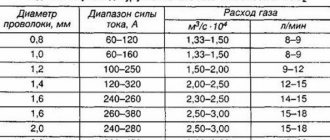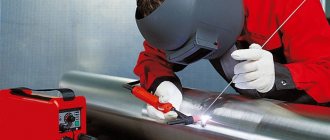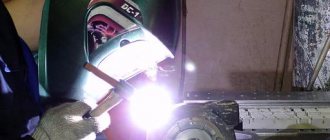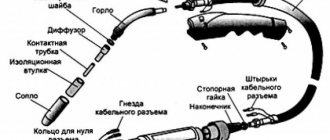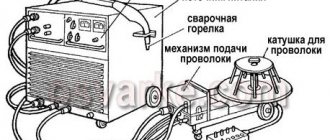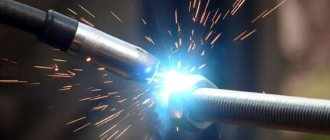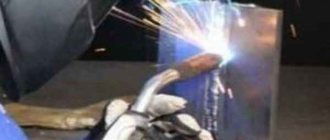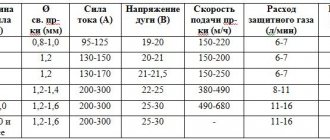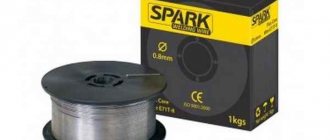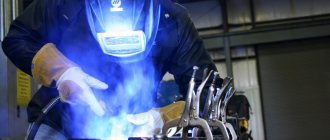Home / Devices
Back
Reading time: 2 min
0
3647
Nowadays, metal welding is performed using different techniques. Stores are overflowing with devices: transformers, inverters, rectifiers, semi-automatic devices and, of course, automatic machines.
They have serious differences. If any master can distinguish between a transformer and an inverter, then, without knowledge of the intricacies of these devices, the difference between a semi-automatic device and an automatic machine is not so clear.
Our publication will show in detail the difference between automatic and semi-automatic welding, and explain the superiority of the first over the second.
An automatic welding machine is a variation of a welding device; it is needed for automatic welding. No special skill is required here. It is enough to configure the equipment correctly, and it will do the rest itself.
An automatic welding machine is a complex technique, but be that as it may, it remains stable under significant loads. Fine adjustment affects the quality of the seams.
Since this method does not require direct participation in the welding procedure, the welder is called an operator.
An automatic welding machine performs several tasks simultaneously. They ignite the arc, make a seam, protect the welding space from exposure to oxygen (flux is used for this purpose), in addition, wire is fed into the welding bath.
- Advantages of automatic welding machine
- Difference between automatic and semi-automatic
- Why then use semi-automatic welding?
- conclusions
general information
An automatic welding machine is a type of welding equipment. The machine is used for automatic welding. Automatic welding does not even require welding skills from the welder. All that is needed is to configure the device correctly. He will do the rest of the work without outside help.
An automatic welding machine for welding is a complex unit, which, however, is capable of operating stably even under significant loads. At the same time, the quality of the seams largely depends on the correctly selected settings. Well, since with this technology the welder does not participate in the welding process itself, he is called an operator.
The automatic welding machine performs a whole range of tasks at once. It not only ignites the arc and conducts the seam, but also protects the welding zone from oxygen (this is done by submerged arc welding machines), and also feeds the welding wire into the weld pool.
Automatic submerged arc welding
When using such welding, the entire process is automated. It is performed using a suspended device or a self-propelled welding tractor. The machines independently ignite the welding arc, regulate its parameters and extinguish it if necessary, provide flux and wire supply, and also move the torch along the seam.
The entire welding process occurs under a layer of flux, a consumable material designed to protect the weld pool from contact with air, as well as deoxidation and alloying of the molten metal. After combustion, the flux forms an easily removable slag crust. It slows down the crystallization of the metal and creates the necessary conditions for dissolved gases to escape from the weld pool. This allows you to minimize the number of defects in the seams.
The basic principles of automatic welding were formulated at the end of the 19th century. However, the practical foundations of such devices were laid by the famous Soviet inventor D.A. Dulchevsky much later, in 1927. It was he who became the creator of the world's first automatic welding machine.
Advantages
Automatic welding has a number of features:
- In fact, the entire process of joining metals occurs under ideal conditions. They are created by a gas bubble, the walls of which are flux. This reduces metal losses due to spattering, evaporation and oxidation to 2-5% (when using manual arc welding, the same figure reaches 30%).
- Automatic welding allows you to maximize labor productivity compared to manual arc welding. In fact, this parameter increases 10 times. This result is achieved by working at welding currents up to 2000 A. As a result, the penetration depth increases and it becomes possible to connect parts up to 12 mm thick (in the case of one-sided butt welds) without cutting their edges.
- After automatic welding, there is no need to clean the metal from spatter. This reduces the overall labor intensity of the work.
- This type of metal connection ensures constant geometric dimensions, shape and chemical composition of the seams.
- The weld pool is reliably protected from contact with air. In addition to this, the slag crust slows down the crystallization of the metal. As a result, the likelihood of defects in the seams is minimized.
- When performing automatic welding, the arc ignites and burns under a layer of flux, and the emission of dust and harmful gases is insignificant, so the welder does not need to use personal protection for the eyes and face.
- Another significant advantage of this type of metal joining is the reduction in energy consumption by 40% compared to manual arc welding. This is possible by streamlining the entire process.
Flaws
Having such a solid list of advantages, automatic welding is not without its disadvantages:
- The main one is the high fluidity of molten flux and metal. As a result, welding work can only be performed in the lower position. The maximum deviation of the seam from the horizontal should not exceed 10-15°. This places a limitation on the use of automatic welding for joining pipes with a diameter of less than 150 mm.
- This method of joining metals is not highly maneuverable. It is only suitable for straight or circular seams. For the same reason, it cannot be used in hard-to-reach places.
- When performing automatic welding, it is important to avoid increased gaps between the edges of the parts. This can lead to flux and molten metal leaking out and causing defects in the welds.
- The burning of an arc under a layer of flux does not allow visual control or adjustment of the welding process.
- Despite the absence of the need to use personal protection, automatic welding causes certain harm to health due to the release of harmful gases.
- The mandatory use of flux increases the cost of welding.
Scope of application
Automatic welding is used to work with various metals and alloys with a thickness of 1.5-150 mm. Its use is possible only in factory conditions. It is in demand in the construction of ships and railway cars, for the manufacture of various large-volume tanks and for connecting pipes with a diameter of more than 150 mm. Automatic welding equipment is most actively used in the serial production of large-sized products for the formation of straight or circumferential seams.
Advantages of an automatic welding machine
The automatic welding machine has many advantages. And they are connected precisely with the lack of the human factor. The machine is able to work continuously throughout the day, producing the same stable result. No other person can boast of the same performance and quality.
In this case, the machine does not care what kind of welding to perform. These can be small parts with thin seams, or large structures. The machine never gets tired and does not require vacation, break or sick leave.
Even if the operator accidentally sets the wrong settings, this problem can be easily and quickly corrected. And if the welder, due to his physical or psychological condition, performs the work poorly, the workpiece will be rejected.
The machine can also perform welding in a position that is difficult for humans to reach. And even more: adjust all settings automatically, if necessary. For example, many machines can easily restore the settings and continue working after a sudden power outage. And this does not require operator assistance.
The machines evenly use consumables, so in production there will never be overconsumption or “sudden” disappearance of gas from a cylinder, coils with wire, etc. Therefore, automatic welding machines are considered one of the most economical, although they require a large amount of electricity for stable operation.
Please note that during automatic welding the operator himself does not participate in the welding process, so there is no threat to his health and life. This advantage is especially important in hazardous industries.
The difference between an automatic and a semi-automatic
The differences between automatic and semi-automatic are obvious, despite the similar names and welding technology. But first things first.
Now you know that automatic welding is carried out directly under the guidance of the operator. The operator sets up the machine, which then performs the entire welding process. In this chain, a person plays the role of an adjuster. It does not ignite the arc, does not lead the seam, and does not monitor the welding. His task is to select the welding mode and give a “command” to the machine.
Semi-automatic welding is a completely different technology. It also uses filler wire, gas, flux and other consumables. But at the same time, the welder does all the work. With semi-automatic welding, a person not only sets up the machine, but also does all the work himself. Simply put, it guides the torch and forms a seam. The only thing that is done automatically is the feeding of the welding wire. Hence the name “semi-automatic welding”.
Which semi-automatic machine to choose?
The choice of semi-automatic devices is made depending on the conditions in which it is planned to be used. To perform welding work at home, that is, in domestic conditions, models whose weight is no more than 50 kilograms and whose power is up to 5 kW are quite suitable. We advise professionals to choose more powerful models. Also, for domestic use, you will need to buy a semi-automatic device, powered by a regular 220 V network, since 380 V models cannot be used in everyday life. The most optimal would be to choose a device that can be powered by both 220 and 380 Volts.
Why do you need semi-automatic welding if there is an automatic machine?
Many beginners, after reading this article, may ask a similar question. After all, at first glance, automatic welding wins in everything. It is economical, productive and eliminates the human factor. But, not everything is so simple.
In most cases, semi-automatic welding is used. Automatic machines are justified only in large-scale mass production, where work is carried out almost without interruption. But such industries make up a very small percentage of the areas where welding is used. In most cases, enterprises and workshops do not need to purchase such expensive equipment. It is easier for them to hire a welder and use semi-automatic welding, since it is more practical when welding in small volumes.
That is why there is no answer to the question: “Which is better—an automatic or semi-automatic welding machine?” It all depends on the specific situation. In some places, a semi-automatic machine will not be effective enough, and in others, an automatic machine will eat up the entire budget of the enterprise and will not justify itself.
Also note that for automatic welding it is necessary to create optimal conditions. Setting up a machine is not an easy task. It should be handled by a specialist who understands all the intricacies and complexities of the process. The machine does not have intelligence and is sometimes unable to avoid critical situations. In addition, a semi-automatic welding machine is much cheaper and more compact than an automatic welding machine. In most cases, it can even be transported along with the cylinder on a special trolley. The automatic machine cannot boast of this.
Otherwise, the automatic and semi-automatic welding process is no different, except for the presence of a person. In both cases, shielding gas, cored wire or flux is used. In both cases, filler material and a burner are used.
Content:
The advent of automatic welding equipment in no way affected the other two popular welding methods.
And although automatic welding has its advantages, at least it increases labor productivity, manual and semi-automatic welding, nevertheless, allows for tighter control of the welding process of metal products. It is clear that manual and semi-automatic welding have significant differences, meanwhile, the process of welding products by these methods is in many ways similar. Next, we invite you to familiarize yourself with the features of each of these two methods of welding metal products.
